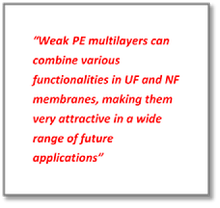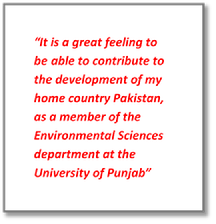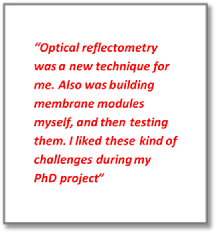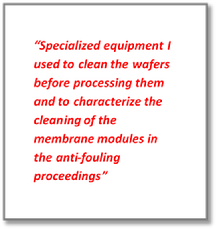 In this thesis the main focus was on using weak polyelectrolyte multilayers (PEM) coatings, to fabricate multifunctional PEM based membranes for liquid applications on ultrafiltration membrane supports. ‘Using weak PEM’s allows for new antifouling and membrane cleaning techniques and strategies,’ Shazia Ilyas says.
In this thesis the main focus was on using weak polyelectrolyte multilayers (PEM) coatings, to fabricate multifunctional PEM based membranes for liquid applications on ultrafiltration membrane supports. ‘Using weak PEM’s allows for new antifouling and membrane cleaning techniques and strategies,’ Shazia Ilyas says.
These polymer coatings were prepared via layer-by-layer assembly, carefully controlling thickness and internal properties. ‘Characterization of each step is important,’ says Shazia. ‘Coating conditions such as pH and ionic strength are crucial, as the layers are very thin, in the order of nanometers.’
If the substrate is porous, such as ultrafiltration membrane supports, the PE multilayers can act as a membrane separation layer for nanofiltration (NF) or even for solvent resistant nanofiltration (SRNF) applications.
‘Here an extra advantage of weak PEM comes into play,’ Shazia explains. ‘The layers may act as antifouling layers as well. Cleaning of fouled membranes is easier as sacrificial removal is possible by using triggers such as: salt, pH and surfactants. After cleaning the clean membrane can be recoated and reused. So: weak PE multilayers can combine various functionalities in UF and NF membranes, making them very attractive in a wide range of future applications.’

The above mentioned functionalities are realized by making suitable choices of weak polyelectrolytes such as poly(acrylic acid) (PAA) and poly(allylamine hydrochloride) (PAH)
‘The starting point of my PhD project initially was focused on novel anti-fouling and easy-to-clean strategies,’ Shazia tells. ‘During the project other functionalities came across. Being able to combine these – and tuning the properties on these new features carefully - that’s when the happy times of my PhD started, really focusing on novel membrane technologies.’
New techniques

During the project Shazia learned many new techniques. For her, membrane science was a new field of research, being a master in environmental engineering.
‘For example characterization techniques were totally new to me,’ she says. ‘Optical reflectometry was one of them. Building membrane modules myself, and then testing them, also was. I liked these kind of challenges during my PhD project very much really.’
Three universities
The work of Shazia was part of the Erasmus Mundus Doctorate program. As a consequence she spent her time working in three different universities: the University of Twente, KU Leuven and Universitiy of Toulouse.
In Leuven she collaborated with the Centre for Surface Chemistry and Catalysis (COK) Group, focusing on solvent resistant nanofiltration membranes. In Toulouse the experts on process engineering from Laboratoire de Génie Chimique (LGC) brought her work further on some decisive matters. ‘From the PhD research some nice publications resulted,’ Shazia says. ‘For example, I was an author in Journal of Colloid and Interface Science as well as in Journal of Membrane Science.’
Twente

‘I started in Twente and returned here,’ she says. ‘Right from the beginning it felt like home to me. I collaborated closely with the Materials Science and Technology of Polymers Group, for example. Also using their plasma cleaner I valued greatly. Specialized equipment I used to clean the wafers before processing them and to characterize the cleaning of the membrane modules in the anti-fouling proceedings we studied. Working within the Membrane Science and Technology (MST) group, in close collaboration with Professor Erik Roesink and Wiebe de Vos, was never-to-be-forgotten.’
Pakistan

After her PhD Shazia will return to her home country Pakistan. She will be working as an assistant professor in Environmental Sciences.
‘It is a great feeling to be able to contribute to the development of my home country, as a member of this department at the University of Punjab,’ she says. ‘I hope to incorporate membrane technology in the curriculum and research programs. That would be a great contribution to the higher education level in Pakistan.’
